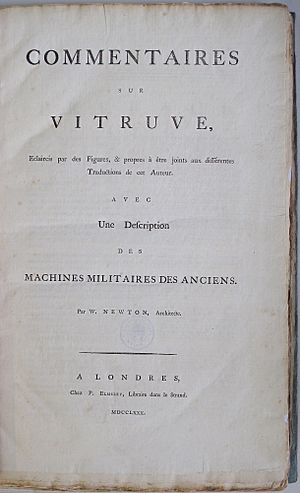William Newton (architect, 1735–1790) facts for kids
William Newton (born 1735, died 1790) was a talented British architect. He designed many buildings and also wrote books about architecture.
Contents
William Newton's Life Story
William Newton was born in London on October 27, 1735. His father, James Newton, was a cabinet-maker. When William was eight years old, he started school at Christ's Hospital. At age 15, he began training to become an architect. He became an apprentice to William Jones, a well-known architect in London.
In 1766, William Newton traveled to Italy. He spent time in Rome, studying the ancient buildings and art. When he returned to England, he joined a group called the Incorporated Society of Artists. He also showed his work at the Royal Academy from 1776 to 1780.
For many years, Newton designed homes in and around London. For example, in 1775, he built a house for Sir John Borlase-Warren in Marlow, Buckinghamshire. He was also very good at designing the inside of buildings. He helped with the design of the London Tavern in Bishopsgate Street.
Working on Greenwich Chapel
In 1781, William Newton started working on a big project. He helped to rebuild the chapel at Greenwich Hospital, London. The famous architect James Stuart was in charge of the project. Stuart was not well, so he asked Newton to help with the designs.
In 1782, Newton became Stuart's assistant. He later took over as the main person in charge of the building work. From then on, Newton designed almost all the beautiful decorations inside the Greenwich Chapel. He also made sure the work was done correctly.
When James Stuart died in 1788, Newton finished the chapel two years later. He also worked on other parts of the hospital. Newton's earlier buildings were in the Palladian style, which was popular at the time. However, the Greenwich Chapel followed older Greek building styles.
After the chapel was finished, some people gave all the credit for its design to James Stuart. William Newton publicly stated that he had designed most of the chapel himself. He explained which parts Stuart had designed and which were his own ideas.
William Newton became ill and left Greenwich in February 1790. He died a few months later, on July 6, 1790, in Sidford, Devon.
William Newton's Books and Writings
Besides designing buildings, William Newton also wrote important books about architecture.
Translating Vitruvius
In 1771, Newton published the first English translation of the first five books of a very old and famous book called De Architectura libri decem. This book was written by a Roman architect named Vitruvius. It was a guide to ancient building methods.
In 1780, Newton published another book in French, called Commentaires sur Vitruve. This book included many drawings and explanations. After Newton's death, his brother, James Newton, finished and published the complete translation of Vitruvius's work in 1791.
Helping with Antiquities of Athens
William Newton also helped to finish and publish another important book. This book was called Antiquities of Athens, written by James Stuart. It showed detailed drawings of ancient Greek buildings. The book was published in 1787.


